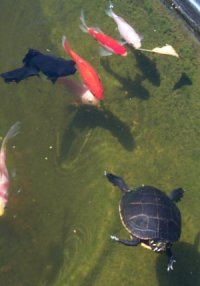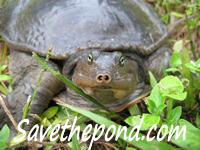 |
 |
|
|
Last Updated: 6/4/09

My indoor pond page has a section on four different people's indoor turtle pond setups with photos.
As I have never had a turtle in my ponds, except for my painted turtle who stayed for all of a week, I am not an expert on turtles or their ponds. If you have links or information that you think people visiting this site will find useful, please e-mail me (see my contact page for details).
The section on protecting outdoor turtle nests may be of interest to those with turtle ponds and breeding turtles.
Visit my main turtle page for links and lots more information on turtles!
Either type of pond can be used for aquatic turtles. The advantage of the liner is that you can form it any way that you like, including the ramps that turtles need to get in and out of the water. A disadvantage is that there is a slight chance a turtle's claws could puncture the liner. It is also often a little easier to bury a pre-formed pond than to use a liner. Pre-formed ponds cost a little more for the same volume of water. This only becomes prohibitive with ponds over about 150 gallons, where a liner is simply much cheaper. For temporary housing outside, a kiddie pool or livestock stock tank with something in the center for basking could be used. Cement ponds are also possible but few people make them anymore. They are usually bad for turtles because they can scratch their shells on the cement and then get infections.
Obviously, "the larger the better" holds true for any animal's accommodations but realistically, a pond that is primarily for water turtles should be in the 50 to 500 gallon range. This allows for easier cleaning and makes it easier to locate the turtles. The pond should have a variety of depths with ramps from one depth to another. For daily resting and sunning, there should be areas only a few inches deep so the turtles can be wet but have their heads free to breathe while resting. For swimming, any area about a foot deep suffices. If you plan to keep the turtles outside year round in cooler climates, they should have a spot that is at least two feet deep (or at least a foot below maximum ice depth) for hibernation (see hibernation). If keeping an eclectic natural pond with a mix of animals (turtles and fish as well as other animals), a pond in the 1000-3000 gallon range would be good.
Land Runs
Aquatic turtles need to get out of the water. While they can do so on rocks and logs sticking out of the water, they should have the opportunity to feel the earth beneath their feet. Females need a sandy or dirt site to lay their eggs. Sometimes, the turtles want to walk around and investigate. The larger the run, the better it is for the turtles. Due to the effort and costs of fencing, it is more realistic to provide from 1 to 4 feet of ground away from the pond on some or all sides from the water.
Alternatives to Land Runs
If you would rather not have a run and fencing, there should be a shear cliff at least a foot high around the water. This could be accomplished with a rock wall or simply not filling the pond anywhere near the top. One can also make a stone overhang of the pond of at least 4 inches and then have the water at least 5 inches below that to keep the turtles inside. It becomes extra important without land to provide logs, rocks, etc. for the turtles to haul out and sun themselves. Many people make an island of rocks, styrofoam, or other materials in the middle of bathtub sized ponds. Larger islands in larger ponds require some ingenuity.
Fencing is necessary if you do not want your turtles to run away (and they would). It also serves to keep out predators. You may need to even cover the top of the enclosure to keep predators out (chicken wire is fine for that), especially for small or rare turtles. The fence should be about 2 feet high above ground. For a more accurate determination of the height necessary, it should be 2.5 times the maximum carapace length for the species you are retaining. Another 6 to 10 inches of fencing should be buried underground as most aquatic turtles will dig. Run a board or some other opaque material along the bottom 4 to 6 inches up or so. This prevents the turtles from rubbing on the wire and getting heads or feet stuck in the wire. It also keeps baby turtles in better. Climb barriers may be necessary for turtles that can climb the fence or the corners. Stinkpots and wood turtles are two species known to be able to climb many feet up a fence. An ideal fence would be vinyl or PVC coated hardware cloth (rabbit wire) over a frame of pressure-treated wood. If a gate is installed, be sure to bury a board under it to prevent digging out.
For a few examples (photos) of outdoor aquatic turtle setups, go to this site.
Here is another person's outdoor turtle cage setup: Rita's Yard.
Aquatic turtles need places to hide both in and out of the water. These provide places to get away from predators and each other. They also allow the turtles to regulate their temperature by moving to warmer or cooler locations during hot and cold spells. During the summer, they must have an area of shade to get out of the sun. Common hiding places include thick vegetation, large flower pots on their sides, hollow logs, and other similar hideaways.
Contrary to some people's beliefs, water turtles are affected by the same chemicals in water as fish. These include ammonia, nitrite, nitrate (high levels), low oxygen, pesticides, herbicides, etc. Thus, their ponds should have a good filtration system. This is especially true since, just like fish, aquatic turtles do most of their eating and defecation in the water. An especially good filter is needed. While an ordinary pond can do with an entire water turnover in two to three hours, a turtle pond should have turnover every half hour or so. Some people would say a turnover every two hours is fine but that really only holds true when there are few turtles in a large, planted pond. I would prefer a larger turnover with turtles in small ponds (under 500 gallons). For example, a 200 gallon pond should have at least a 400 gph pump. There should be a good pre-filter like a sponge or floss. This will need to be cleaned as often as it clogs, perhaps daily. The biological filtration should be adequate to keep ammonia and nitrite levels undetectable. An example setup might be a Pondmaster 700 (700 gph pump) in a 200-400 gallon pond. Remember, a 700 gph pump only pumps at 100 gph if it is old or clogged. If you can change about 10-20% of the water every week or two, that should be adequate if you do not have more than one turtle per 50 gallons or so. It is okay to change up to 50% of the water at one time as long as the temperature is close and proper amounts of de-chlorinator are added if one has city water.
If the conditions are right, aquatic turtles can over winter in your pond. It will probably be okay if the following are true:
For a ton more information on winterizing ponds, see my pond winterizing page.
Also, see my section on hibernation of turtles.
Check out this link:
How Turtles
Overwinter Under Water
If you have wild turtles laying eggs around your ponds, you may chose to let nature take its course. If on the other hand, you have pet turtles who are breeding and living in their own pond, babies may be born. If left to fend for themselves, they are in grave danger from predators. A hatchling aquatic turtle is easily swallowed whole by a heron or raccoon. For this reason, if you wish to improve their chances, either enclose the pond or raise the baby indoors. The pond must be enclosed on the sides and the top as turtle-eating birds will come from above (and animals like raccoons that climb fences). To improve baby turtles chances, add lots of vegetation and places to hide in the pond. Larger turtles (especially snappers) may eat baby turtles so it is often best to raise babies away from adults. For temperate species that are often winterized outdoors or in refrigerators (in plastic shoe boxes with an inch of water and holes in the lid), it is not usually a good idea to put a newborn through a true winter the first year unless it has spent the previous season outdoors as for those born in the wild. It takes the babies time to fatten up for winter and get used to the correct triggers to tell them what to do. It takes time to find the right place to hibernate. Hatchlings thus born too late in the year (October or later) may not survive their first winter.
For more on baby turtles, see my hatchling turtle page and index.
Building a Pond - the CA Turtle and Tortoise Society page on building a turtle pond.
Janice's Turtle Pond - 4000 gallon turtle pond
The Turtle Puddle - a summer-only outdoor pond for a few turtles
Pond Construction - an article on Austin's Turtle Page by Wendy.
Plans to Build a Floating Turtle Island
Turtle Pond - photos of one person's turtle pond with a little information
Turtle Ponding - a long article turtle ponds (not just turtle pond specific).
See my other turtle links (some contain pond information and some do not) section.
If you know of any good sites, please let me know!

|
|
|
Return to the main turtle page. See the master index for the turtle pages.
|
Click below to vote for Robyn's Turtle Pages as a Top Turtle Site!
|

|

|
E-mail RobynCopyright © 1997-2026 Robyn Rhudy |

|
 |